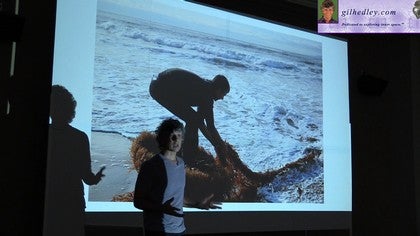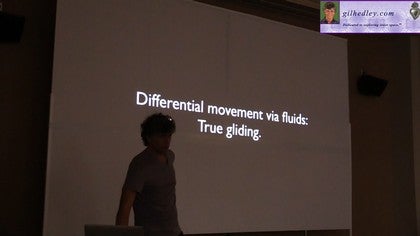Description
This video was filmed and produced by Gil Hedley. It includes videos and photos of dissections of cadavers (embalmed human donors). You can visit his website for more information about his workshops.
About This Video
Transcript
Read Full Transcript
Hi, I'm maybe some of you were like me are very movie as a kid. [inaudible] 10 years old. You get the ball, you run, your friends run after you call you the Christian [inaudible] ball. They take the ball. I can do that for hours now. Let's go character. That was my favorite thing.
That's the way it is at a party. Right? Go look. Kids are running around their tableau around them. They're wrestling with each other. They're running around the house and up the middle age or the parents, they're all [inaudible] the sprinkling mushrooms in the job. [inaudible] [inaudible] watching people [inaudible] in their eyes.
[inaudible] so the stages of movement throughout your life. Now, when I went from that tremendously moving young child, and then I kind of wrote on bike high school, but particularly in the 70s we had a weightlifting machine in the gym called the universal machine universal machine that had several stations, bench press, military press, all that pole down and light press run around a certain zillion. By the junior year in high school, I'd be bored walking around like this. [inaudible] range. The notion of the universal machine [inaudible]. Eventually I got religion and started doing taking the St Francis and I always wore my hood up, walk around like a monk and by the time I got to graduate school I was pretty much like, I'll turn on. I read for hours and hours.
I was like a professional reader now to read it. Hold on. [inaudible] as I walked around the library with my foot off, if the weather was fair, I would go out to on lake shore, drive or walk from the south side. She taught all the way to a loop, six, eight miles maybe just reading, reading class, the picture. Can you see the movement pattern had changed and I even, I record [inaudible] I love meeting at the University of Chicago's Club night. Right? I saw this group of people as not, it doesn't happen with a leader who was like a great heron teacher, diversity, Chicago type sheet Alpha. I thought it was the most beautiful scene. So I joined the club [inaudible] seven years until I was going to go and see [inaudible] so much choreography.
It took me two hours a day just to maintain my choreography. [inaudible] had become a tremendous boom to my range of motion from this stage had become like a straight jacket over the course of time and I had to move differently. Some of that exploration took place through my Raul thing or off the trade. Uh, for instance, uh, I stood in front of my raw form from my first evaluation and my first session is stand there in your underwear in this report. Right. I'm like, he said, just stand up on me. I'm like, okay. And it looks out from your hand. Polaroid says, [inaudible] stop doing that.
[inaudible] I was like, well, like I knew I had him doing something right. My call was to talk from my diaphragm straight back and Chin and to him and it was like I was a techy guy man. So I got my 10 sessions right there and shit. I cried on the way to the bus seven times that night. Not from the touch, but from the fact that I was allowing line move again in a way that had sort of disk permitted based on my ideas of what it meant to walk like a Tai Guy. And when I went to the institute and we getting more movement training and I walked in front of the class, James, does she ever walk in front of class and I walked like this squad, they're going to evaluate my, my advocate, my walkie pattern, some tear laws, uh, eyes six inches.
So from the 16 primary on the ground, uh, to, to avoid the computer since of the eyes. Right. Because of a monk kind of looks up and catches too. [inaudible] [inaudible] you consider raising your eyes to the horizon? I rarely saw exactly what I see now. So I was a marvel, but this warm group of people who are looking at me with appreciation, kindness, and hoping the best for me. And I thought, Huh. [inaudible] ask them up to the horizons father, the mother of my children [inaudible] so Watson [inaudible] movements crept into my behaviors. Another thing. I would practice the [inaudible] outside in order to get catcalled basically [inaudible] were you bullied to increase our focus?
[inaudible] call that I got more than once because it looks really prey, but you don't have any cheap. Okay. I mean that was like so mean. [inaudible] she got that. She it [inaudible] I'm thinking I'm really taking this card on my [inaudible] my teacher, Jim [inaudible] just keep taking my money, but I'm kinda on me about the cheek is pissed off the parent or the this guy walking on. What does sex do in that?
This guy having sex [inaudible] I was saying [inaudible] [inaudible] so turns out that anger [inaudible] [inaudible] she was not the anger at sex. That was a bit of my Chihuahua. What was that? It was continuous kind of going up. I couldn't permit it myself. Emotion, emotion, those movements. Yeah, it fit with my identity.
Just spaces, dehydration and inflammation. Those are secondary effects. Identifications for relationships, behaviors, churches, families, communities, cultures in which we are moving in which we are structuring our movement patterns. Right. And creating limit cycles for ourselves and within those limits cycles we grow them up some of our body and allow some of it to move right?
Depending upon the identity your allow yourself to move in different ways and everybody could start the tape sheet guys at the University of Chicago because we all along the same way. Alright. And I could spot the other Catholics in my community and you could, you could build up those, those, those bits and pieces together. All right. You see it's all the way down to the motor units, right? You were looking at Greg gross differential movements in the body and the footage that I showed you, but if I could show it to you all the way down to the motor units, all the amount of time anatomical named things aren't functional units. As truck isn't a functional unit, it doesn't function all at the same time. Right. If all the fibers of gas struck fire at the same time, that's not functional.
That's a Charlie [inaudible]. That's what that is, right? Functional is where it's some units are on and some units are off or they trade off back and forth between one another. Alright, so right next door to each other and monitoring and inspiring. We're not in this differential moment at that very level and that very level, these behaviors and patterns and associations and self identifications are played out. And when you take someone into movement choreography as a pilates instructor, as a yoga teacher, when you rub on them as a melter or take him through Uri centrix program or yoga to knock them, you massage him or raw foam or what have you, right? You're, you're actually disrupting that set of compensations and making an invitation to move into and live in these tissues that you're touching. Consciousness comes there and says, is this my home too?
Is this a room in my house, a mile out to live and move here too? Is he answer? If, cause, if I can do this, just kind of create a very different set of relationships in my home. Maybe I just got one son [inaudible] open doors right in that home. She could have been waiting for years to see that walk through the door, but it could also get doors shut tonight and when they come back to you next week. Okay. Exactly like they did the week before.
I don't shame them for that because they could've taken that richness stuff was offered home and found that hall wasn't quite ready for that yet. Sorry. Thank you very much. And again, everybody at their office that it was divorced. [inaudible] is incredible. Transformative life changing bias coloration and you achieve a whole new level of self where you can now be angry or you can enjoy your sexuality or you can live in every bit of your body, right? Then it does it fit because you're not moving by yourself.
There is no yourself. There's only the nest of relationships, don't you swirling. Just something to be mindful of when you're working with people and inviting them beyond their place. You're all in transformational territory doing what y'all do.
Just like with the compensations that are around, which we organize ourselves in our communities. I'll take you through some compensations in the musculoskeletal system. Here's a trench like scar in a in a gentleman's belly. The skin is it become out here to the deep fashion, the superficial fashion to heal across the incision. That's going to change the movement.
Otherwise, if I take away that superficial fashion, you can see that people were, and this scar, this form, this ain't the enemy folks, right? The scars are our friends. I really want to be able to heal gaping wounds in our body, right? This is a good thing. Scars, they're a good thing. This is, this is homeostasis. This is staying on the planet longer. If you can't do this, you don't stay on the planet as long in the form of a rich. Now, when I see large incisions in the visceral spaces, I become suspicious about hegemons and investor on themselves, right? Because that's a site inflammation.
I expect things to stick at this point, having seen so much evidence. So you see, we're going to see all the evidence and the viscera of what's happening in our musculoskeletal system, especially in the way more obvious and investor up. Because so's gliding surfaces will be sticking to each other. In fact, in this same body, you see that the greater omentum isn't adhering to this car stuck to it, and the greater omentum was like a superficial fashion inside your couch. It's a padding gay person hanging in the mesentery light tissues and apparent to know, uh, extensions of the stomach and the transverse colon as a three edge and it wanders around inside your body like an internal medical doctor visiting various inflamed or it isn't. And throwing one blanket over them, right. Acting like a clay poultice, drawing white toxins and, and um, and generally doing good stuff for you.
And sometimes in the course of its therapeutic interventions, it gets stuck there.
And if there are vectors of movement that are inhibited there that you once had and you'd want to play with it and see, maybe we could reclaim those movements. Right. But again, this is a demonstration of healing and the client with this one, we found it to be quite novel. I don't think it causes any trouble at all. We're just looking at the evidence [inaudible] here we have a on six body on shoulder, chest, head, neck, chest, muscle.
I always leave a couple extra feet of wire before regiment. Close-Knit little green snips in two feet of wire on your couch. So there's a pacemaker, a different role there. And is that the pocket that the surgeon put in to hold it not that's an encapsulation of this. Your body produces. This is brilliant. This is interesting.
It's like a hybrid fascia. Okay. Is, I call it a hybrid fashion. It's not called the tell me fashion. It's not quite the the interaction, right? It's like the filming Fascia felt it. It's a felt five organization. It's all heavily tickled me and never questioned and denser that we find in the, in the Sony fashion with its excursus potential, it doesn't have excursively potential. It's like the deep fashion that way and also thicker and opaque.
This is an unfixed body we can see for. All right, so we have this sculpted sack that the body is going, this is an immune response, a healthy immune response to a foreign object in your body. So I put a foreign arms you can buy, I like to use the mouth, pastoral, pastoral metaphors for the immune system. My, my t-cells aren't coats, I don't have killer t cells. There's no martial metaphor in my body. I under I'll, I'm killer t cells around the march have different germs to shoot. Right? That's a killer case. And I have goats. We might go to know their shepherd and if it's not their shepherds who can and they can eat it. [inaudible] can and [inaudible]. No, they can't.
They can't digest that. They can't make it go away. They're allowed to eat it because it's not the shepherd, but they can. So they try and push it out to have horns. [inaudible] [inaudible] they can't push it off so the body covers it in its own tissue. It wraps it in some tissue. Now the gods come by, they just recognize the shopper. We can't eat that. Let me just move along, move along along. Right now it's encapsulated. Just like we've talked about that bladder being covered in the recipient's own cells.
This thing is not covered in the recipient cells and you're no longer trying to get rid of it. It's just part of the part of the C in this capsule capsules. So that's a beautiful immune response and we can pretty much depend on growing with no matter what we stick inside of our bodies. So this is actually addressed in plants. This is the skin layer. And then this superficial factional layer. No, is that the deep Fascia? Now that's a encapsulation. Okay, so these are the implants.
These are the capsules. The body will grow a capsule. It's a normal healthy immune response to a foreign object in Invitae. Can't be ejected.
We are the species that plays with itself. We Pierce our bodies. You Tattoo our bodies. We stay close. John Likes, we live in Vancouver or Florida and our bodies respond like I am. I am heat tolerant. You are cold tolerant. That's physiological and your body's changed, aren't we? Were we play with ourselves much for yourself in different parts of the planet, moving in different ways. Putting your face in our mouth, can we get from this are our body's got nothing against it.
That's that's like our sport. My daughter's trying to do tattoo artists just fricking tied it up like you wouldn't believe it. That's awesome. I don't care if that's what she wants to do. So someone's is fine and also know that it will encapsulate. I've seen encapsulation so dense and so thick filling in a room around that on the chest wall that I absolutely thought at first glance that they had put Tupperware sleep. Yeah, come home with me. All right, and when you have grown something damn sign your chest wall, this is going to effect your breathing is going to affect your movement.
Now, you might be planted and maybe you're not a yoga lady. You don't care if it was 10 to 20% of your breathing because you want the ties. I think that's a choice. That's okay, so you're willing to sacrifice x many percent and then maybe we'll do that because you [inaudible] a world class athlete or something and an Olympic athlete who loses 1% of the potential is like you get the gold. I said that wonders and managed to is mission critical, but am I making mission critical for you? But still you're going to need to move on. You're going to need to squeeze in.
You're going to need to just walk up to strangers and say, would you like to feel





You need to be a subscriber to post a comment.
Please Log In or Create an Account to start your free trial.